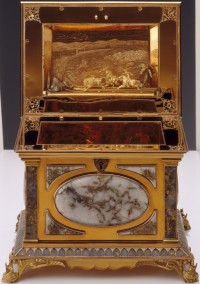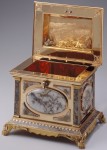 The depressing trend of thefts from California Gold Rush museums continues, doubtless driven by the high price of gold ($1,693 an ounce as of yesterday). The latest victim is the Oakland Museum of California. Early Monday morning, January 7th, a thief broke into the closed museum through a locked door on an outdoor garden. He then made his way to the second floor exhibit through an emergency exit door and stole one artifact: a Gold Rush-era jewel box made out of California gold and gold-veined quartz. (A second artifact, a scale used to weigh gold, valued at around $2,000, was taken but did not leave the premises. Curators found it elsewhere in the museum.)
The depressing trend of thefts from California Gold Rush museums continues, doubtless driven by the high price of gold ($1,693 an ounce as of yesterday). The latest victim is the Oakland Museum of California. Early Monday morning, January 7th, a thief broke into the closed museum through a locked door on an outdoor garden. He then made his way to the second floor exhibit through an emergency exit door and stole one artifact: a Gold Rush-era jewel box made out of California gold and gold-veined quartz. (A second artifact, a scale used to weigh gold, valued at around $2,000, was taken but did not leave the premises. Curators found it elsewhere in the museum.)
The jewelry box was in a plexiglass display case rigged with an alarm. A security guard heard the alarm and saw the theft on the surveillance video, but he was in another part of the museum and the burglar got away before the police arrived.
The beautiful piece is one of the greatest treasures of the museum’s extensive 1.8 million-object permanent collection and is worth at least $800,000. The museum hasn’t released the exact monetary value because the artifact hasn’t been appraised in years and its historical value far eclipses its market price.
The historic jewelry box, was made between 1869 and 1878 by A. Andrews, a San Francisco goldsmith, and is signed. It is made of California gold, and features a rectangular moulded top and base that rests on four feet formed of four miniature female figures depicting allegorical California. The artifact is seven inches in height; nine inches on length; and seven inches in depth. The top pilasters and mouldings are of veined gold quartz in tones of grey and cream with veining of gold. The interior of the top is recessed and engraved in full relief with scene of the early days of the Union and Central Pacific Railroads, mounted Native Americans, herds of buffalo, and a train of cars. The gold quartz is cut and set in mosaic fashion in the top of the lid, exterior and the sides are gold veined quartz.
It was reportedly commissioned by a California pioneer as an anniversary present to his wife. It’s a one of a kind object, the epitome of a California artifact in design, material, workmanship and ownership history. The Oakland Museum of California is dedicated to the art, history and natural history of California, and this piece qualifies on every score.
 The museum’s insurer is offering a $12,000 reward for the safe recovery of the jewelry box. (People involved in the theft in any capacity, before, during or after, cannot claim the reward.) The thief is going to have a hard time selling it because it is so recognizable. Museum officers fear that the thief plans to melt the box down for its sheer gold value.
The museum’s insurer is offering a $12,000 reward for the safe recovery of the jewelry box. (People involved in the theft in any capacity, before, during or after, cannot claim the reward.) The thief is going to have a hard time selling it because it is so recognizable. Museum officers fear that the thief plans to melt the box down for its sheer gold value.
The last time the jewelry box was stolen (it has a bit of a record, I’m sad to say) was in 1978. The thief sold it intact, thankfully, and it eventually made its way back to the museum in 1985 when an art appraiser found it and returned it after he realized it had been stolen.
The museum has been a more recent target of theft as well. This is the second burglary at the museum in two months. The last break-in also happened on a Monday, on November 12th, 2012. Gold nuggets and other artifacts were the target that time. Again the alarms went off and the police arrived within three minutes of the guards’ call to 911, but again the thief was faster than they were. Based on surveillance video, authorities believe both burglaries were done by the same man.
The museum is asking that anyone with information contact the Oakland Police Department’s Major Crimes Section at (510) 238-3951 or the tip line at 855-TIPS-247. You can also text TIP OAKLANDPD to 888777.
Meanwhile the museum is beefing up its security, already markedly beefed up after the November break-in, and has hired a security consulting firm to see what else they can do to take the bullseye off their back.
What is the lining on the inside of the box? Looks like red velvet material of some sort. Astonishing craftmanship – what a terrible waste it would be to melt it down for the sake of selling it… That guy should be melted down himself!!
i thought it might be a tortoise-shell, perhaps, because it’s swirly. Jewelry boxes usually have soft linings, however, so maybe a taffeta? It’s horrific to think of such a work of art being destroyed for its metal. You can’t even extract the gold from the quartz by simple melting, so really only the interior lid and base have meltable gold. I honestly hope he gets a smart, believable accomplice to dodge the insurance company’s conditions and turn it in for the reward.
Reports are that it’s the same thief for both thefts. If they were after gold the first time, I have no doubt that’s what they wanted this time as well. The worst part is that the museum guards there aren’t allowed to confront theives, just report it to the police. I’m betting money that the museum will get hit a few more times before they change that.
It’s a shame, I vaguely remember the box, but now that it’s gone I really want to see it again!
You don’t know what you’ve got and all that. So you’ve been to the Oakland Museum of California, I gather. Do you have specific recollections of its Gold Rush collection? I’m wondering why the thief didn’t just help himself to more of the easily meltable stuff. I doubt he cleared them out the first time, or if he did, none of the news stories said as much.
What a shame! It is a beautiful piece of art; I do hope it’s recovered before it’s destroyed!
I wonder if it is possible to identify the thief with the video camera.
The authorities are keeping mum on many of the details. If they could identify him as the same man, however, it seems to me at least some distinguishing features are visible on the security camera footage.
If this ends up as gold flake on fancy cheeseburgers or plating for cubic zirconia Home Shopping Club rings I’m gonna freak out.
I know that his is an unfortunate part of the life cycle of gold. I’m sure Egyptian burial goods became Roman jewelry which in turn became Gothic coins, but this somehow seems worse.
Oh man, I can’t even think of the glories that have been melted down by conquerors and marauders over the millennia. It makes my tummy hurt. At least those events happened long ago, though. This one is so close to us.
You said it yourself – this lovely object is one of the greatest treasures in the museum.
The question of value is an interesting one, for the thief as well as for the museum’s funders. Even if the appraisal was up to date and it was worth three times the suggested $800,000, how can anyone factor in the box’s historical value?
Exactly, there’s no way to convert that kind of value into cash. Monetary value is assessed based solely on what people will pay for a given object. Its value to the state and people of California is incalculable.
The thought of some ignorant bastard breaking this up and melting it makes me nauseous…How high/desperate would you have to be to do such sacrilege? But the fact it seems like the same guy both times, maybe a collector is sort of “commissioning” him to grab certain things and its all going into a private collection where at least it will be safe for the moment. We can only hope…
It does seem rather specific. If he was just looking for gold to melt, he could have stolen nuggets or dust like he did the first time. It’s sad that we have to hope it winds up in the underground market instead, but that worked the first time it was stolen.
I live in Oakland, but haven’t been to the museum in a while so I’m not sure what’s left in the gold rush collection. I don’t recall there being so much gold as other items. I understand the thief stuck to nuggets the first time.
[Marcus] Livius Drusus… As you like call yourself… As another looking from the outside in, you seem to have spent an incredibly great deal of time assessing your history and knowing very precise details about this specific object..
Does anyone have any information or theory regarding the 1978 theft? The box was taken to Sotherby’s in Lafayette, CA